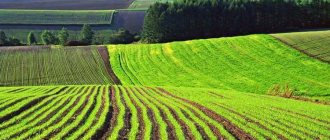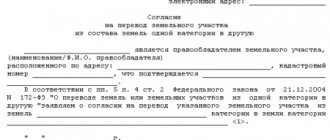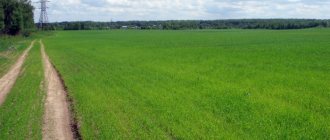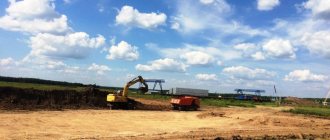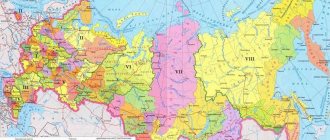Industrial lands are areas intended for the construction of facilities for the purposes of manufacturing, mining or residential services. Plots located in the agricultural fund cannot be used for the listed needs. In this regard, land is being transferred from agricultural to industrial use.
As a rule, industrial lands are formed on the basis of areas created earlier, on which production facilities once operated. Another way of education is to change the category of land.
Why convert agricultural land to industrial land?
In order to use agricultural plots for their intended purpose, serious financial investments are required. Such lands, as a rule, are located outside populated areas and are not equipped with communications.
Meanwhile, servicing industrial facilities requires transportation and other resources. All this is difficult to implement on agricultural land, so translation is required.
The advantage of such sites is that, due to the distance from the populated area, it is possible to expand the territory of the industrial complex, if necessary. When the area for production is located within a city or town, any expansion is difficult. Most often, you have to rent a plot of land in another place, which is not profitable, since transportation costs and other costs increase.
The legislative framework
The transfer of land plots to the category of industrial land is carried out by a decision of local authorities , which is accompanied by changes in data on land plots, as well as the types of their permitted use within the cadastral database of the Unified State Register of Real Estate.
Changes in land categories are carried out on the basis of the following legal documents:
- Land Code.
- Regional legislation.
- Law number 172 “On the transfer of lands or land plots from one category to another”
Important! The list of categories to which certain lands may belong is given in Article 7 of the Land Code of the Russian Federation. Article 8 of the same Code indicates that the change of categories of agricultural land is carried out by the land departments of regional administrations.
As for filing petitions with authorities, the nuances of preparing the required documentation and considering appeals, these are regulated by Law No. 172. Local laws also determine the form, as well as the regulations for the application of persons who are interested in changing the category of a separate land plot (clause 2 of Article 2 of Law No. 172).
When is it permitted to transfer agricultural land to another category?
The main difficulty is that it is not always allowed to transfer agricultural land to another category. This is permissible in the following cases:
- Conservation and creation of a specially protected area, as well as changing the type of permitted use of the site to recreational, environmental, etc.
- Adjustment or establishment of the boundaries of a populated area.
- Placement of industrial facilities whose cadastral value exceeds the market average.
- Fulfillment of international obligations.
- Mining.
- Placement of municipal, domestic or social facilities, as well as for educational and healthcare purposes.
- Construction of power lines, roads, railways and various pipelines.
In accordance with Art. 79 of the Land Code of the Russian Federation, it is impossible to transfer agricultural land to another category if the cadastral value of the future site exceeds the average for the region by more than 50%. The transfer of particularly valuable and productive lands is also prohibited.
Is it possible and how to translate?
The particular fertility of agricultural land is the basis for strict control over their turnover by the state authorities.
For example, the construction of any buildings on such plots of land is prohibited at the legislative level .
However, if, due to a certain number of circumstances, the construction of buildings on such sites is still necessary, then the norms of the current legislation provide for the possibility of transferring agricultural land to the industrial category.
The condition for the transfer is the following circumstances:
- The cadastral assessment of the site recognized its value as the statistical average for a certain area.
- The construction of industrial facilities on the territory of a certain agricultural area is a proven necessity, dictated by production goals.
The conditions from the second paragraph may include, for example, the need for strategic development of the region, which includes agricultural land subject to transfer to the category of industry, increasing production capacity, etc. In addition, the reason for changing the corresponding category of land plots may be the need construction of communication stations or irrigation systems.
Attention! The transfer of land to the category of industry is unlikely or even impossible when these lands are of particular value to the state due to their increased fertility, the location of nature reserves or nature reserves on their territory, etc.
How to convert agricultural land into industrial land
Changing the category of land is a lengthy procedure. If the reason for transferring the land to industrial is valid, then it is necessary to draw up an application, prepare documents and transfer the package to the municipality or other body within whose competence the land is located.
A reclamation project must be attached to the package of documents. This is a set of measures that is necessary to restore the environment as a result of conducting the planned type of activity. In addition, state environmental assessment is applied.
After reviewing the reclamation project and other documents, a decision on transfer will be made. If it is positive, then a resolution is drawn up, in accordance with which the land category is transferred. To do this, you should contact Rosreestr or MFC.
As a result, the applicant is left with a transfer act, an extract from the Unified State Register of Real Estate and a land lease agreement. The last document is issued when the land is transferred for use on a lease basis.
In what cases can a transfer be refused?
Refusal is possible in the following cases:
- upon receipt of negative results of an environmental assessment, if this procedure is necessary;
- based on the restrictions established by the current legislation of the Russian Federation;
- if the declared category does not comply with the approved territory development plan.
In addition, changing the category of agricultural land is impossible under the following circumstances:
- the cadastral value of the plot is 50% or more higher than the average cadastral value of land established for the region (Article 79 of the Land Code of the Russian Federation);
- The site is classified as particularly valuable agricultural land.
If a refusal to transfer land to another category is received, the owner of the plot has the right to appeal this decision in court within 3 months. Satisfaction of the claim is possible only if the applicant provides a clear justification for his claims.
Documents for transferring land to industrial use
If the land plot meets all the requirements for transfer, then the following documents must be prepared:
- application - drawn up in the name of the head of the municipality, the text indicates identification information about the site and a request to change the existing category;
- general passport;
- extract from the Unified State Register of Individual Entrepreneurs - if the applicant is an individual entrepreneur;
- extract from the Unified State Register of Legal Entities - if the applicant is a legal entity;
- title document and its copy (the basis document by which a person uses the site);
- technical documentation for the land plot;
- boundary plan;
- certificates in forms KV-1, KV-2, KV-3 - issued by Rosreestr;
- documents confirming ownership of buildings erected on the site, if any.
If the land plot is leased, you will also need to obtain the owner’s consent to change the category of land.
All documents can be transferred in person, through a representative, or by sending a registered letter with a list of attachments and acknowledgment of delivery. When a representative acts on behalf of the applicant, it is also necessary to provide a notarized power of attorney.
If, as a result of consideration by the administration, a positive decision is made, then the next stage of the procedure is to undergo examinations, obtain the consent of various authorities, protect the created project and make changes to the Unified Register of Rights.
To apply to Rosreestr you will need the following documents:
- application for amendments to the register of rights - issued by an employee of Rosreestr or MFC or can be found on the official website of the department;
- boundary plan;
- cadastral documentation;
- an extract from the Unified State Register of Real Estate, which indicates the ownership of the plot by the owner;
- municipal permission to change the category of land;
- general passport;
- results of the examinations carried out;
- project of the planned production facility.
Even at the stage of collecting documents and preparing an application to change the category of land, you may need the help of a lawyer. It is better to contact a specialist in advance to prevent errors and violations of the law.
What is the difference between land plots allocated for production?
Plots of the first type are difficult to develop, because old buildings are located here and various engineering communications have been laid that have lost their relevance. Before starting the construction of new buildings and creating the infrastructure of modern industrial production, a lot of effort and money will be required to get rid of unnecessary residues.
Territories of the second type were previously cultivated for agricultural crops, they are located far from cities and towns, there are no old houses, buildings, or communication lines. These lands also require large financial investments, because industrial production begins to develop almost from scratch.
A big plus is the potential for access to raw materials if there are appropriate deposits at this location. The fact that populated areas are located at a distance gives hope for future expansion of production capacity.
Legal regime of industrial lands
The regime for the use of industrial land is established taking into account the development of the industry. In a general sense, industrial sites are intended to accommodate production facilities.
In land legislation there is the following definition of industrial land. These territories are intended to support the activities of enterprises and the operation of production facilities. Such lands may include protected areas and sanitary protection zones with special uses.
An important element of the use of an industrial site is the need to comply with sanitary standards and rules. For example, trees should be planted along the perimeter of the site. In this way, the standards established regarding permissible pollution of the territory are observed.
If difficulties arise, please seek legal advice. You can get free legal assistance on our website. in a special window.
Converting land from agricultural use to industrial use is a complex, lengthy and labor-intensive process. It can drag on for up to six months. Contacting a lawyer in a timely manner will help speed up the process.
Required package of documents
The following documents must be attached to the application:
- extract from the state land cadastre;
- a copy of the applicant's passport;
- a copy of the document confirming the applicant’s right to own the land plot;
- act of environmental assessment, if its implementation is provided for by law;
- calculation of losses in the agricultural or logging industry;
- consent of the owner of the land plot to transfer this property to another category.
Legal entities, in addition to the listed documents, must attach an extract from the Unified State Register and a copy of the company's Charter.
Citizens of foreign countries must provide a translation of documents confirming the identity of the applicant, executed in writing and certified by a notary.
A package of documents can be submitted to the authorized body personally by the applicant, his representative (if there is an appropriate power of attorney) or by registered mail with notification and a list of enclosed documents.
Transfer of lands from agricultural lands to lands of populated areas.
Source data provided by the reader:
A land plot with cadastral number *** has the following characteristics:
| Cadastral number | *** |
| Address | *** |
| Square | 12500 +/- 78 sq. m. |
| Cadastral value | RUB 85,206.25 |
| Land category | Agricultural land |
| Type of permitted use | For the construction of a grain processing base |
| Type of right / copyright holder | *** |
A land plot with cadastral number *** has the following characteristics:
| Cadastral number | *** |
| Address | *** |
| Square | 29,985 +/- 1,516 sq. m. |
| Cadastral value | 204 392.75 |
| Land category | Agricultural land |
| Type of permitted use | construction and placement of a grain processing base |
| Type of right / copyright holder | *** |
Legal analysis:
The transfer of a category of land from agricultural lands to lands of other categories is carried out in accordance with the Federal Law of December 21, 2004 No. 172-FZ, paragraph 1 of Article 2 of which determines that for the transfer of lands or land plots within such lands from one category to another An interested person submits a petition for the transfer of land from one category to another or a petition for the transfer of land plots from one category of land to another to the executive body of state power or local government body authorized to consider this petition.
Clause 2 of Article 2 of the Federal Law No. 172-FZ dated December 21, 2004 establishes that the content of a petition for the transfer of land from one category to another and the composition of the documents attached to it are established by the state authorities of the constituent entities of the Russian Federation in relation to agricultural lands , with the exception of lands owned by the Russian Federation.
Decree of the Government of the Orenburg Region dated April 1, 2009 No. 132-p defines the requirements for the content of an application for the transfer of land from one category to another and the composition of the documents attached to it in relation to agricultural land.
In accordance with Appendix No. 2 to the Decree of the Government of the Orenburg Region dated April 1, 2009 No. 132-p, the following documents are attached to the application for the transfer of land from one category to another:
- Identification documents of the applicant:
A. passport of a citizen of the Russian Federation - for individuals;
b. extract from the Unified State Register of Individual Entrepreneurs - for individual entrepreneurs;
V. extract from the Unified State Register of Legal Entities - for legal entities, executive bodies of state power, local government bodies of municipalities of the Orenburg region.
- Consent of the applicant, an individual, to the transfer and processing of his personal data in accordance with the legislation of the Russian Federation for the purpose of considering and making a decision on the issue of transferring land from one category to another (hereinafter referred to as transfer).
- A document confirming the relevant powers of the applicant’s representative (if the application is submitted by the applicant’s representative).
- An extract from the Unified State Register of Real Estate for a land plot, the transfer of which from one category of land to another is supposed to be carried out (hereinafter referred to as the land plot), issued by the authorized body no more than six months before the applicant submits a request for transfer.
- Consent of the legal owner of a land plot to transfer a land plot from one category of land to another, duly certified, except for the case where the legal owner of the land plot is a person with whom an agreement has been concluded to establish an easement in relation to such land plot.
- Conclusion of the local government body authorized to provide urban planning activities, the corresponding municipal formation of the Orenburg region on the compliance of the requested intended purpose of the land plot with the approved territorial planning documents and documentation on territory planning, with the attachment to the said conclusion of fragments of maps of territorial planning documents with the boundaries of the land plot drawn in accordance with an extract from the state real estate cadastre.
- Conclusion of the state environmental assessment, if its implementation is provided for by the legislation of the Russian Federation.
- Act of the local government body authorized to dispose of land resources, the corresponding municipal formation of the Orenburg region (hereinafter referred to as the local government body) on the creation of a specially protected territory and objects or on the creation of specially protected natural areas or the classification of lands as lands of environmental, historical, cultural, recreational and other particularly valuable purpose (in case of transfer on the basis of clause 2 of part 1 of Article 7 of the Federal Law of December 21, 2004 No. 172-FZ “On the transfer of lands or land plots from one category to another” (hereinafter referred to as the Law).
- An approved land reclamation project (or the corresponding section of project documentation) provided for the extraction of mineral resources, a license for the right to use subsoil, a mining allotment act, documents containing information about the location of land plots relative to the boundaries of the provided mining allotment (in case of transfer based on clause 8 of part 1 Article 7 of the Law).
- An approved project for the reclamation of a part of agricultural land (or the corresponding section of project documentation) provided for the period of construction of linear facilities (in case of transfer on the basis of clause 6 of part 1 of Article 7 of the Law).
- Conclusion of the local government body on the absence of other options for the location of objects (in case of transfer on the basis of paragraphs 4, 7, 9 of part 1 of Article 7 of the Law).
- Justification of the area of the land plot, agreed with the local government body , with the exception of the transfer of the land plot on the basis of clause 8 of part 1 of Article 7 of the Law.
- Title and (or) title documents for a real estate property in the case of the presence of buildings, structures, structures, unfinished construction objects on the land plot, in the absence of information about registered rights to the corresponding real estate objects in the Unified State Register of Real Estate.
- Consent of the owner of the property to the transfer if there are buildings, structures, or unfinished construction objects on the land plot.
- Decision on land conservation (in case of transfer on the basis of paragraph 1 of part 1 of Article 7 of the Law).
In addition, the Federal Law of December 21, 2004 No. 172-FZ “On the transfer of lands or land plots from one category to another” in paragraph 2 of Article 7 determines that the transfer of agricultural lands or land plots as part of such lands from agricultural lands destination, the cadastral value of which is fifty percent or more higher than the average level of cadastral value for the municipal district (urban district) , and especially valuable productive agricultural land specified in paragraph 4 of Article 79 of the Land Code of the Russian Federation is not allowed into another category , except in cases established by paragraphs 3, 6, 7 and 8 of part 1 of this article.
The cadastral value of a land plot with cadastral number *** is 85,206.25 rubles, the area is 12,500 sq.m. (1.2 ha). That is, the cadastral value of 1 hectare of this land plot is 85,206.25 / 1.2 hectares = 71,005.21 rubles. / ha.
The cadastral value of a land plot with cadastral number *** is 204,392.75 rubles, the area is 29,985 sq.m. (3.0 ha). That is, the cadastral value of 1 hectare of this land plot is 204,392.75 / 3.0 hectares = 68,130.92 rubles. / ha.
The type of permitted use of both land plots *** and *** is “for the construction of a grain processing base.”
The average level of cadastral value for lands of the agricultural category of group 1 in the Orenburg region in accordance with Decree of the Government of the Orenburg Region No. 1003-p dated October 13, 2011 (group 3 - agricultural lands occupied by buildings, structures, structures used for production, storage and primary processing of agricultural products) is 68,200.00 rubles/ha.
Thus, in order to transfer the category of a land plot with cadastral number ***, the obstacle is that the cadastral value of this land plot for 1 hectare is equal to 71,005.21 rubles. / ha, which exceeds the average level of cadastral value per 1 hectare for lands of the agricultural category of 1 group in the Orenburg region equal to 68,200.00 rubles. / ha. To eliminate this obstacle, it is necessary to challenge the cadastral value of a given land plot in a pre-trial (or judicial) manner, reducing the cadastral value below the average level of cadastral value.
Note: group 3 of agricultural land involves land plots occupied by buildings, structures, structures used for the production, storage and primary processing of agricultural products. According to the Unified State Register of Real Estate, these land plots do not have buildings, structures, or structures located within their boundaries used for the production, storage and primary processing of agricultural products. In this regard, it is likely that when considering a petition to transfer the category to the Ministry of Natural Resources, these land plots will be classified as group 1 - agricultural land suitable for arable land, hayfields, pastures, occupied by fallow land, perennial plantings, on-farm roads, communications, forest plantations , intended to ensure the protection of lands from the effects of negative (harmful) natural, anthropogenic and man-made phenomena, as well as water bodies intended to support on-farm activities, for which the average level of cadastral value in the Orenburg region is 24,390.85 rubles/ha.
Graphical analysis:
In order to determine in which functional zone, according to the general plan of the Yuzhnouralsk village council of the Orenburg district of the Orenburg region, land plots with cadastral numbers *** and *** are located, extracts from the Unified State Register of Real Estate were obtained for both land plots.
Figures No. 1 and No. 2 respectively show the location of land plots *** and *** on the public map of Rosreestr
Figure No. 1: Fragment of the public map of Rosreestr - land plot ***.
Figure No. 2: Fragment of the public map of Rosreestr - land plot ***.
Figure No. 3: Fragment of the diagram of the functional zones of the general plan ***.
Figure No. 4: Fragment of the diagram of the functional zones of the general plan *** – symbols.
As a result of spatial analysis, it was determined that the land plot with cadastral number *** is located in two territorial zones:
— recreational area;
- production area.
It should be noted that this situation (when one land plot is located in two territorial zones) violates paragraph 7 of Article 11.9 of the Land Code of the Russian Federation dated October 25, 2001, No. 136-FZ.
A land plot with cadastral number *** is located within one territorial zone - an industrial zone.
Appendix No. 2 to the Decree of the Government of the Orenburg Region No. 132-p dated 04/01/2009 determines that an application for transfer of the category of land from agricultural lands to lands of populated areas requires the submission of a conclusion from the local government body authorized to ensure urban planning activities, the corresponding municipal education of the Orenburg region (*** village council *** district of the Orenburg region) on the compliance of the requested intended purpose of the land plot with the approved territorial planning documents and documentation on territory planning (General Plan *** village council *** district of the Orenburg region) with an appendix to the said conclusion fragments of maps of territorial planning documents with plotted boundaries of the land plot in accordance with an extract from the state real estate cadastre.
Thus, in order to obtain the conclusion of the local government body on the compliance of the requested intended purpose of the land plot with the approved territorial planning documents and territory planning documentation, it is necessary to carry out work to amend the General Plan *** - change the boundaries of the settlement to include the territory of the land plots *** and *** into the settlement *** and forming a new functional zone - a residential zone.
Conclusions and recommendations
To eliminate possible reasons for obtaining a decision on the refusal of the Ministry of Natural Resources, Ecology and Property Relations of the Orenburg Region to transfer the land category of land plots with cadastral numbers *** and ***, it is necessary:
Clause 7 of Article 11.9 of the Land Code of the Russian Federation dated October 25, 2001 No. 136-FZ “The formation of a land plot, the boundaries of which cross the boundaries of territorial zones, forest districts, forest parks, is not allowed, with the exception of a land plot formed for carrying out work on geological exploration of subsoil, development mineral deposits, placement of linear objects, hydraulic structures, as well as reservoirs and other artificial water bodies.”
- To challenge the cadastral value of a land plot with cadastral number *** in a pre-trial (or judicial) manner, reducing the cadastral value below the average cadastral value for the Orenburg district of the Orenburg region;
- Carry out work to amend the General Plan *** - changing the boundaries of the settlement, including the territory of land plots *** and *** in the settlement *** and forming a new functional zone - a residential zone.
Refusal to change the category of land
The applicant may be refused at the stage of submitting the application. Reasons for this may be that the person does not have the right to submit a petition, as well as incorrect or incomplete execution of the required attached documents. To re-apply, you must eliminate all the shortcomings indicated in the refusal documents.
An official refusal to transfer a plot of land to another category is made on the grounds listed in Art. 4 Federal Law 172:
- restriction (prohibition) on transfer to another category imposed by current legislation;
- the declared category contradicts the intended purpose of the allotment;
- The environmental state examination has identified the negative consequences of the upcoming transfer.
Another reason why a transfer cannot be made is if the cadastral value of the declared territory is too high (more than 50% relative to the average value for the region). In any of these cases, the applicant will be returned the full package of documents within 30 working days from the date of submission of the application, notifying him of the reason for the refusal.
The applicant can challenge the decision through the court and, if the court decides positively, send a new petition. The appeal procedure is as follows:
- Obtain the act from the property and land department.
- Draw up and submit a statement of claim to declare the drafted act illegal. Attach documents to the application:
- a photocopy of the issued act;
- a copy of the application and accompanying documents;
- documentation confirming the illegitimacy of the refusal or permission to transfer;
- receipt of payment of state duty;
- other documents related to the trial.
- Having received notice of the place and date of the hearing, appear in court at the appointed time.
- If the court satisfied the requirements of the statement of claim, obtain a copy of the court decision from the office.
- Submit a second petition, attaching the court decision to the package of documents.
Categories of land in Russia
The Land Code (hereinafter referred to as the Land Code of the Russian Federation) divides land into the following categories:
- Industrial. Plots in this category are allocated for the construction of transport routes and buildings, buildings for the defense and security of the country, for energy, communications and scientific programs buildings and other special purposes.
- Lands of populated areas (hereinafter referred to as ZNP). Plots allocated for the development of residential properties. The main feature of such lands is that they cannot be located on land territories for other purposes or in private ownership.
- Agricultural purposes (hereinafter referred to as Agricultural Purposes). Land resource necessary for the production of agricultural products: pastures, arable lands, plots for gardening and horticulture, forest shelterbelts, reservoirs for growing fish and lands of similar properties.
- Water fund.
- Specially protected. These include territories that are withdrawn (partially withdrawn) from general circulation and are of valuable importance.
- Forest fund (read: how to get forest for free from the state).
- Reserve lands. State plots that have not been transferred for use to citizens or organizations and have not been sold into ownership.
Required documents
The initiator of changing the category of an agricultural plot will need the following documents:
- Russian Federation passport;
- Certificate from the Unified State Register of Legal Entities – for legal entities;
- Certificate from the real estate register about the owner of the land plot;
- Cadastral passport;
- Conclusion of the environmental commission;
- Owner's consent to change the category of land.
The latter document is prepared if the initiator is a tenant of a private land plot or the holder of an easement.
A certificate from the Unified State Register can be ordered from the MFC or Rosreestr by presenting your passport and paying a fee (300 rubles).
To obtain the consent of the environmental commission to change the category of a land plot, you need to contact the regional office of Rosprirodnadzor and order an examination. Its cost is set by local legislation, and the period for issuing an opinion can be 1-4 months.
